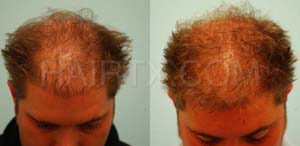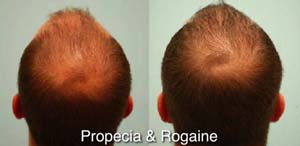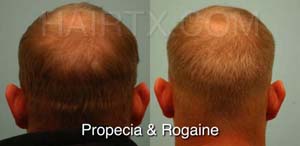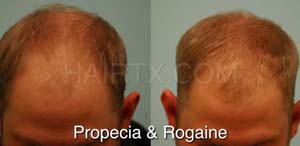Propecia (Finasteride)
Finasteride (brand-name Propecia) is a daily oral medication that helps to slow down and somewhat reverse male-pattern baldness.The progression of hair loss is expressed in two ways: first, shortening of the hair-growth cycle, and second, diminishing of the hair-shaft size/diameter. In other words, hair loss is seen as a process of hairs shrinking from healthy terminal hairs that progressively miniaturize to fine, vellus hairs.The mechanism by which finasteride works is through blocking the conversion of testosterone to dihydrotestosterone (DHT) via an enzyme 5-alpha-reductase Type 2. With less DHT present, fewer hairs are susceptible to the hair-loss process; some hairs are growing again; and some hairs are growing thicker.Propecia takes several months of usage before visible signs of hair growth are present. The Hair Genome Test can offer a very precise dosing regimen that is based on your genetic profile. Although the standard oral 1 mg dose is highly effective, Dr. Lam believes that a genomic evaluation that uses your saliva can help fine tune your dosing for optimal results whether you go the topical or the oral routes.
Oral finasteride has received negative press regarding unwanted sexual side effects. However, Dallas hair transplant surgeon Dr. Sam Lam still believes it is overall a very safe and effective therapy, especially to treat male-pattern baldness. He uses various alternative modes of delivery to minimize risk of side effects in men and women who are sensitive to the oral regimen like topical finasteride and injectable dutasteride, the latter of which has no truly reported sexual side effects. As mentioned, he also prefers to use a hair genome test to evaluate your precise level of dosing based on your genetic sensitivity and resistance.
In today’s culture, use of testosterone pills, creams, injections, etc. have unfortunately accelerated hair loss in men who are already sensitive to the effects of DHT. Although testosterone usage can be safely taken by men who do not have signs of hair loss, men who are experiencing hair loss must be hyper aware of this risk. Tracking one’s hair loss history can also be helpful by noting whether hair loss has more rapidly progressed while on testosterone. Unfortunately, there is no direct link between a testosterone numerical value in your blood and what may cause hair loss since everyone reacts and responds differently to the effects of testosterone. Especially if you are on testosterone, you may truly consider the importance of using finasteride of some kind.
Be careful to be using generic finasteride, especially coming from overseas like Mexico. The risk of getting products with adulterated ingredients or low activity can be high. Dr. Lam only uses high-grade, selected compounding pharmacies to attain the highest quality medicines for his patients.
Contact Us Today! Read Our Manifesto Visit Our Gallery
Key Points
- An ideal candidate
- A male experiencing hair slowly diminishing in volume over time (miniaturization
- A male who would like hair transplant surgery but would also like to slow down his current hair loss with medical therapy
- Women who are post-menopausal, have an imbalance of testosterone, or who have no risk of giving birth to children.
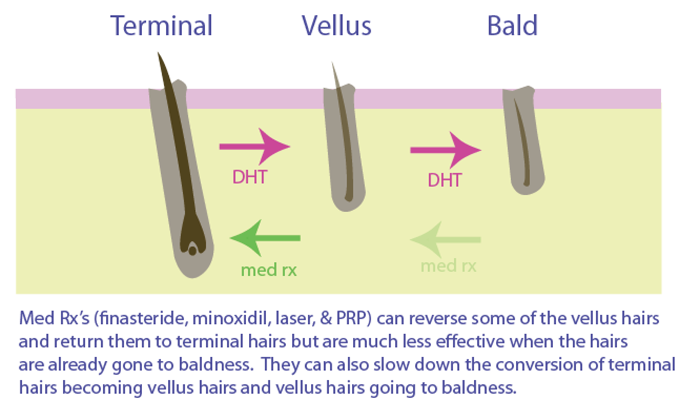
- What to do
- This is a prescription-only medication and Dr. Lam can write your initial prescription for you. You must sign a consent form that describes the risks, benefits, and limitations of finasteride before receiving the prescription.
- The Hair Genome Test can provide a very accurate oral dose for you beyond the standard 1 mg, whether higher or lower, and can also provide valuable information if you go the topical route.
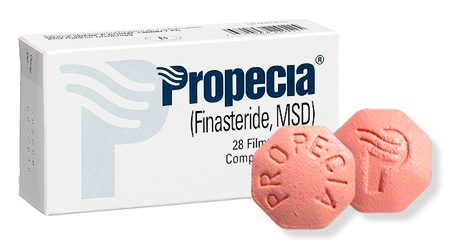 What to expect
What to expect
- The change in hair appearance may show as early as 4 to 6 months and should continue to improve over the ensuing months. Your hair should slow down in shedding and you could see an improvement in hair count and hair volume. We will follow up with you to take photos and monitor your progress
- In preparation for a hair transplant, the strengthening of the hair is experienced as early as 4-6 weeks, which may decrease the extent of postoperative shock loss but not completely prevent it. Of note, you may notice some temporary increased shedding 4 to 8 weeks after starting finasteride since some of the hairs may be being pushed into a growth, or anagen, phase. This shedding does not always occur though. Dr. Lam today feels that his Folliflo product line is the ideal product to help with reducing the risk of shedding around the time of surgery.
- Oral finasteride can be combined with oral minoxidil into a single pill that is precisely formulated for you after taking the Hair Genome Test or as a standard empiric dose instead. The standard combined oral dosage would be 1 mg of oral finasteride with 5 mg of oral minoxidil
FAQs
-
Does it work for every patient?Finasteride is highly effective and works in 99% of men who take it. Some patients have decided that it did not work for them and usually, the reason for this is that they just failed to notice the difference (that is why we have standardized photography) or continued to lose more hair despite the benefits of finasteride. Although finasteride can slow down hair-loss progression and improve hair growth, in younger men with rapid hair loss there still could be ongoing hair-loss progression. The hair genome test can help you determine your level of sensitivity and the right dosing that would best benefit you.
-
Do I need minoxidil or other medical therapies if I am on finasteride?In short, yes, if possible. Minoxidil works synergistically (or additively) with finasteride. Someone who has been on finasteride for a long time and then adds minoxidil should see an uptick in improvement. Conversely, someone who has been on both finasteride and minoxidil and who stops one or the other product will notice a similar worsening. As many therapies (finasteride, minoxidil, laser, and PRP/Hair Stem) that one can afford, can tolerate, and desire because all of these methods are additive in their benefits. Finasteride offers the strongest benefit for the patient but all therapies are very helpful when used in combination. Dr. Lam will help consult with you on the pros and cons of all the medications to help you decide which combination of medications may be ideal for you. The Hair Genome Test can help you whether minoxidil would also be beneficial for you and at what dose.
-
Tell me about the side-effects.The most common side-effect of finasteride is a sexual side effect, typically a reduction in libido that could in some patients lead to erectile dysfunction. In rarer cases, there can be breast tenderness or change in mood, especially if someone has already been on anti-depressants. The initial studies have shown an incidence of less than 1% compared with placebo for sexual side effects but some uncontrolled post-marketing surveys have raised the alarm of permanent sexual side effects in a small group of men. Although there have been scattered reports, there have been no large-scale clinical reports about this trend, and Dr. Lam finds that this medication is not only highly effective but very safe as well. There has also been a documented incidence of what is called a nocebo effect, i.e., simply counseling someone about the potential for a side effect can lead to the occurrence of the side effect.
-
If I experience side effects, what can I do?In initial Merck studies, they found that 57% of men who continued medications for a month or more had complete resolution of any of their side effects. Accordingly, it may be worth continuing the medication for a minimum of one month before coming to a conclusion about whether you should continue or not. Another option if side effects do arise is to consider taking one pill every other day rather than daily. In Dr. Lam’s experience, doing so has taken care of the majority of issues in those who experience them. The effectiveness of finasteride may be somewhat reduced but it is still worth taking it at this reduced dosage.
-
What if I stop taking the medication?Unfortunately, all of the hair that is preserved during the time you are on finasteride will be lost over several months when the medication is stopped. To clarify, if you have been on the medication for 5 years and then stop, the amount of hair that was preserved during that time will be lost (not more hair than you would have lost). This can be very discouraging to hear but with such an effective medication available, Dr. Lam likes to help your psychology by saying: “Keep taking finasteride for as long as you care that you have hair or until a better medication comes around.” Of note, there are so many technological breakthroughs that are on their way like prostaglandin modulators (both topical and oral), DNA 3D printing of follicles, etc. However, if you don’t start taking finasteride and wait until these medications arrive on the market you may have irreversibly lost so much hair that finasteride or another medication will be less effective. Accordingly, you should start your medication as soon as you can and be as compliant as you can.
-
What does dutasteride (Avodart) do compared with finasteride (Propecia)?Dutasteride (marketed as Avodart) is a dual alpha-reductase inhibitor blocking both alpha-reductase type 1 and alpha-reductase type 2. Finasteride (Propecia) only blocks type 2. Accordingly, finasteride only blocks about 65% of circulating DHT; whereas dutasteride can block up to 99% of circulating DHT. Based on the Hair Genome Test, you may be a better candidate for dutasteride, which the test will reveal. Oftentimes, the results of the test will recommend a dose that is not standard but instead tailored to your genetic profile.
-
What if I am taking Proscar already?If you are taking Proscar (which is a 5-mg form of finasteride) for prostate BPH condition, then you don’t need to take Propecia since that would be overkill. The 5 mg Proscar will provide the coverage you need for the hair as well. However, 5 mg dosing has been shown to have equivalent benefit as the 1 mg dose so if you are only using Proscar for your hair, then you are most likely overdoing it. Again, the Hair Genome Test can more precisely evaluate your precise dosing needs.
-
Does it work for women too?Earlier studies found no benefit in postmenopausal women. More recent studies have shown that finasteride may help postmenopausal women who experience hair loss. Caution should be exercised in women of childbearing age because it can lead to birth defects in children for women who take finasteride during their pregnancy The Hair Genome Test will give precise information as to your genetic sensitivity and dose should you desire to incorporate it into your treatment plan with the risks and limitations stated above taken into consideration. Today, Dr. Lam mainly uses all-natural products like Folliflo, Hair Stem, and his invention using Botox to help with hair loss.
-
I heard that finasteride only works well in the crown region but not in the front of the scalp like the hairline.This is false. The reason why the package insert only states the efficacy of the crown is that initial FDA trials only evaluated the crown, so the package insert has to reflect the parameters of those clinical trials. Nevertheless, subsequent to those trials, studies have shown that finasteride works very well in the front and the back of the scalp.
Videos
Photos
For more Propecia (Finasteride) Before & After Photos, Click here
 Lam Institute For Hair Restoration
Lam Institute For Hair RestorationSchedule a Consultation
If you’re interested in learning more about finasteride (Propecia) in Dallas, TX, contact our office to schedule your informative consultation at the Lam Institute for Hair Restoration. Our team will happily guide you through the treatment process and address any questions or concerns that arise along the way.
Related Blog Posts
Dallas Hair Restoration Surgeon, Dr. Lam, Lectures in St. Louis on Ethnic Hair Restoration
Dr. Sam Lam, Dallas hair transplant surgeon, lectures in St. Louis on ethnic hair restoration, encompassing African, Asian, Hispanic, and Middle Eastern hair restoration. Part 1: African and Asian Hair Transplant Part 2: Hispanic and Middle Eastern Hair Transplant… Read More
Ethnic Hairline Designs for Hair Transplantation
When creating a hairline for a particular individual, it is important to consider many factors, one important element is ethnic sensitivity. Hairlines differ based on gender, facial shape, and age as well, and these are starting points for any physician in his/her design work… Read More
Understanding Traction Alopecia and The Role of Hair Restoration
Traction alopecia refers to hair loss that arises from hair being pulled too tightly for too long causing permanent destruction to that hair. Most typically, this condition is caused by tight hair braiding, as seen more commonly in African-American women… Read More

